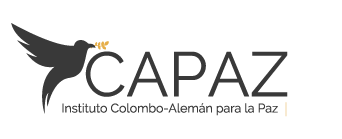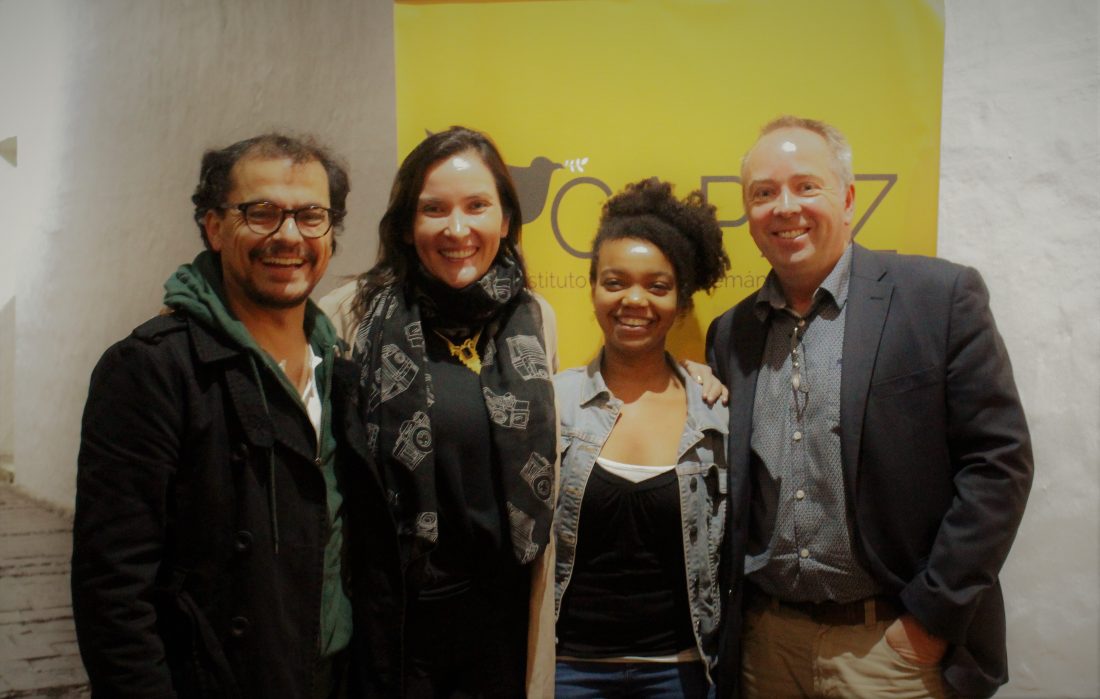
VISUAL AND AUDIOVISUAL REPRESENTATIONS OF THE COLOMBIAN ARMED CONFLICT
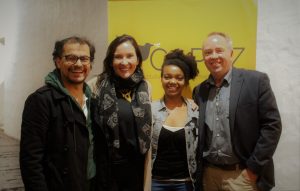
(From the left to the right): Carlos Nupia, administrative director of CAPAZ; Erika Diettes, Milo del Castillo and Dr. Wolfgang Fuhrmann. / Photo: Claudia Maya
In one of the exhibition halls of the Claustro de San Agustín in Bogotá, German film scholar Dr. Wolfgang Fuhrmann talked with the documentary filmmaker Ana Milena del Castillo and the visual artist Erika Diettes.
The event was held on Thursday, November 22, 2018, and took place in an atmosphere different from that one created by purely academic discourses or hectic political debates. With the event CAPAZ aimed at approaching the Colombian armed conflict from an audiovisual, photographic and artistic perspective and to reflect on the diversity of possible artistic representations of the conflict.
The (living) light of the victims
In her first documentary “Written Conflict”, filmmaker Ana Milena (Milo) del Castillo presents the stories of three women that have been victims of the conflict. The protagonists tell their personal experiences to the camera, totally relying on the subtle work of del Castillo, who was born in Tumaco, Nariño, one of the most affected zones by the armed conflict.
The film’s quality lies in the stories of the three female voices that experienced all sorts of violence, that are burned-in their bodies. Del Castillo intercut the women’s discourses with dancing sequences, that function as a liberating intertitle between the three testimonies. The dancing is at the same time a narrative resource; like a breath taken in order to continue to live in the body, and today.
Milo del Castillo staged the women in a space that was more symbolic and avoids any cheap showmanship. She used a black background that emphasized the dark past that contrasts with the light on the faces and gestures of the women. Del Castillo arranged the space in such a way that she could also translate her ethical position: the light on their faces like coming from their inner to go forward in their lives.
Objects, images, rituals
How do you collect the pain and the memories? How do you express them, where to deposit them?
For her art installation “Relicarios” (Reliquaries), Erika Diettes received personal objects from those who are “dolientes” of the conflict (those in pain). The artist prefers to use this term rather than “victim”, as a sign of respect for the continuing mourning of the bereaved.
After years of accompaniment with the families, Diettes’ treatment of the objects creates a space of communication between the objects themselves, the physical (artistic) space and the spectator. The objects are stored in urns, placed on the floor with their own lighting above. Whoever wants to observe them carefully must kneel down, almost like praying.
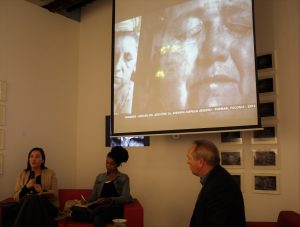
Erika Diettes explained the process of her art installations. / Photo: Claudia Maya
Names, birth places of people or dates of their disappearance are not mentioned. The reliquaries are just numbered, a method that might seem a little arbitrary, but necessary according to the artist’s ethics. Because in the end what matters is the object and its living memory value.
In her work “Sudarios” (Shrouds), Erika Diettes uses huge photographs of mourning women that are printed on translucent fine backdrops. In places such as churches the artist plays with images and light in such a way that her portraits become monument.
A testimony as presented in both artists’ work transcends the written or verbalized word. Documents differ from artistic works by the language they are using. At the end, the objects of the mourning families of Erika Diettes’ work, or the testimonies presented in Milo del Castillo’s documentary, were given to the artists in order to act as interpreters of the memory, of the mourning process, using visual and audiovisual language.
In the end, the promotion of art
The pleasant and thought-provoking conversation ended with a discussion on the current state of art promotion in Colombia. Both, del Castillo and Diettes agreed that applying for financial support becomes a wasteful, inaccessible, almost indecipherable task due to the procedure’s complexities. So many talents and so few opportunities, or at least so unknown to many.
Erika Diettes went even further and argued that it is necessary that the artistic education, no matter what art it is, should also teach and develop capacities in the formulation of artistic projects or cultural management. It should promote also a dialogue between languages and expertise, right as it was the case that evening at the CAPAZ Institute.
